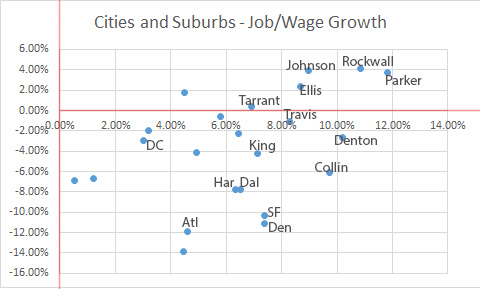“Sticking feathers up your butt does not make you a chicken.”
—————————————–
The Dallas Morning News publicized two rankings from very credible sources showing Dallas to be doing very well. Well, sort of. The first is about available mobility options from TxPIRG where Dallas ranks 12th of 70 cities and Austin (!) ranks 1st. Red flags all over the place. Like all emerging city rankings, as everyone searches for the holy grail of objectivity, we must look deeper.
First, the report is nearly one hundred pages dedicated to one simple ranking: how many varied transportation services, modes, and technologies are available. This is simply checking boxes rather than a measure of their utility. Each of the modes included could and should include weighted measures within that particular mode or service. What’s the transit ridership? What’s walkscore? How often are ride-sharing apps used? Do they appreciably reduce drunk driving? How many bikes are in the bike share system and what’s the annual membership? What’s the zipcar membership? Are VMTs trending downward?
In other words, this is a very shallow look at available technologies. In a way, it’s really just a measure of tech friendly places. Just look at the top ten: Austin, San Fran, DC, NYC, etc etc. So it’s not a measure of places where you can go car-free because the best measure for that is still the amount of people who do. People make rational choices based on their needs, circumstances, and surroundings. The more people that do go car-free, chances are the land uses and transportation options are best arranged for that to occur.
—————————————-
The other isn’t so much a study, but a report by the Bureau of Labor Statistics showing that the DFW Consolidated Statistical Area created the most jobs in 2014. First, this is a good thing. But we all know the area is booming and has been for some time. And also, this is for CSA. The DFW CSA is massive. From memory, it’s something like 16 counties. The question is which counties are accounting for that growth. As we’ve seen in the past, it wasn’t Dallas, but the others.
It should also be noted that this is net growth of total jobs. Not wages nor percentage growth. From a net growth standpoint, you’re basically wiping out majority of the competition since only huge metros can compete. I also find it helpful to compare apples to apples; urbanized counties to urbanized counties, even if they might be different varieties of apple species. At least it’s a little more clarity, context, and depth.
So, as per usual, I took an hour early this morning to look at county by county data in the region and then cross referenced to other urbanized counties (and a few suburban counties across the country). I haven’t had time to do a more exhaustive list of the 40 largest urbanized core counties like previously, so this will have to do for now. BLS data is also not available on a county level past Q2 2014. So instead of 2014, I’m using Jan 2013 through June 2014 since I’ve previously assembled county level data through 2012.
So how are we doing? I mean really doing?

Not bad. Not nearly as bad as the 2001-2012 period, but still, “not great, Bob.” There we are right next to Harris County, which actually added more net jobs but slightly lower percentage growth if we really want to play that game. Sprawling Atlanta is the really big loser here. The only dot below them is Fulton County which has to be added together with DeKalb since the city of Atlanta is split down the middle between these two if you like things ridiculously complicated.
From an urban county standpoint (at least from those I’ve charted), Dallas and Harris are in the middle. Travis (Austin) and King (Seattle) are doing better in both metrics. In Austin’s case, fairly significantly. Sure, our sample size is pretty low at this point, but it somewhat refutes the “We’re number 1!” mantra. Not to look too deep into it, but both Seattle and Austin are emerging tech hubs with oodles of infill happening. I’ve been to both in the past six months and am always struck by how many cranes there are, how urban the developments are, and how concentrated the activity is.
The two dots off to the far left are suburban DC counties, which were gangbusters up to 2013. The top right are all DFW suburbs. In other words, as far as the CSA rankings are concerned, it’s the DFW suburban counties carrying us. But at least, Dallas county is net positive and about 40% of total job growth. So that’s a good thing. However, those doing the best percentage wise are the least developed suburban counties. They’re basically the rural counties, suburbanizing. We’ll see how they’re doing in 30 years. To me, it only supports the hypothesis that Texas is inflating the ‘miracle’ by doubling down on 20th century policies. Quantitative growth, rather than qualitative.
It’s not like Dallas is out of land even though it’s effectively bounded on all sides. From a metro standpoint, we should be preserving as much of that fertile soil and rural land for water retention and recharge as possible. Unfortunately, we’re not thinking about those long-term life- and growth!-sustaining foundations of life: predictable and protected sources of food and water.
Instead, there are no adults in the room as we continue to subsidize new highways into greenfields, a development model sure to fail in a generation or two. We should point that growth inward and southward to better balance the jobs/housing/tax base/tax burden imbalances that exist and make for a whole host of systemic problems. That is, if there are any adults in the room.




